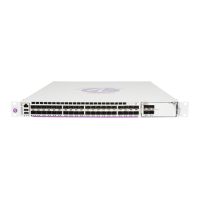Initializing and Provisioning
7705 SAR-A Chassis Installation Guide 109
Step 5. (Optional at this time) Assign an IP address to the router. Refer to Telnet
Connection for quick reference information and to “Initial System Startup Process
Overview” in the 7705 SAR OS Basic System Configuration Guide for detailed
information.
Step 6. (Optional at this time) Configure or modify the primary, secondary, or tertiary BOF
file locations. Refer to Telnet Connection for quick reference information and to
“Initial System Startup Process Overview” in the 7705 SAR OS Basic System
Configuration Guide for detailed information.
Step 7. (Optional at this time) Run automatic discovery protocol (ADP).
ADP is a factory-installed boot option that automates the initial commissioning of
7705 SAR-A nodes. ADP runs automatically the first time the system is powered
up. The Power/Alarm Status LED blinks green and amber while ADP is running.
See Automatic Discovery Protocol for more information.
Troubleshooting Initial Startup
If the system cannot load or cannot find the boot.ldr file on the integrated flash memory
device (cf3), the system will reboot continuously in an attempt to successfully find and load
the file. If this happens, the faulty chassis must be returned to Alcatel-Lucent for replacement.
If the system finds the boot.ldr file, the system processes the initialization parameters
from the BOF. The BOF should be on the same drive as the boot.ldr file. If the BOF
cannot be found or loaded, then the system prompts the user for alternate software and
configuration file locations.
When the software is successfully loaded, control is passed from the boot loader file to the
software. The runtime software attempts to locate the configuration file as configured in the
BOF. The file includes configurations for the chassis, control and switching functions, and
ports, as well as system, routing, and service configurations.
Figure 25 displays the directory structure and file names on the integrated flash memory
device.

